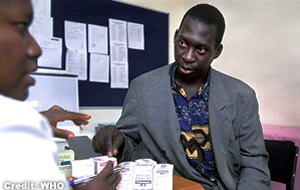|
|
|
|
|
| AIDS- HIV |
|
 |
| WHO: Fighting against HIV-AIDS |
 |
Antiretroviral
treatment (ART) can keep people alive and transform HIV/AIDS from a death
sentence to a manageable chronic disease.
TASO Clinic in Uganda, 2004 WHO/Michael Jensen |
 |
Antiretroviral
treatment enables people living with AIDS lead a normal and productive
life.
Sheila and her son are living with impacts of HIV like millions around the world. Gaborone, Botswana, 2003 WHO/Eric Miller |
 |
WHO
and partners work for simpler, more affordable and accessible HIV/AIDS
treatment and prevention in developing countries.
Hoima town pharmacy in Uganda, 2004 |
 |
TASO
Clinic in Uganda, 2004
WHO/Michael Jensen |
 |
Broader
availability of AIDS treatment boosted HIV testing, offering more people
an incentive to know their HIV status.
The young mother had an HIV test and is being counseled on AIDS treatment. TASO Clinic in Uganda, 2004 WHO/Michael Jensen |
 |
Under"3
by 5" global target, fixed dose combination drugs are becoming more and
more available in developing countries. FDCs offer ease of distribution
and storage and likelihood of greater success in AIDS treatment.
National Medical Stores in Uganda, 2004 WHO/Michael Jensen |
 |
Antiretroviral
treatment brings hope to millions infected and affected by HIV/AIDS.
At the launch of "3 by 5" initiative in Nairobi, Kenya WHO/Sven Torfinn |
 |
HIV/AIDS
has left more than 14 million orphans in Africa alone. Children and infants
can and should be treated.
ART clinic in Uganda's Hoima region provide treatment to AIDS orphans. WHO/Michael Jensen |
 |
Nairobi,
Kenya
WHO/Sven Torfinn |
 |
Odessa
AIDS Clinic, Ukraine, 2004
WHO/Viktor Suvorov |
WHO HIV/AIDS department has a photo library of more than 1400 photos developed and produced by WHO and its consultants in various regions and countries. The photos can be freely used for non-commercial, educational and information purposes, crediting the authors.
| Links |
| External Links |
|
|
|
|
|
|
|
|
|
|
|
|